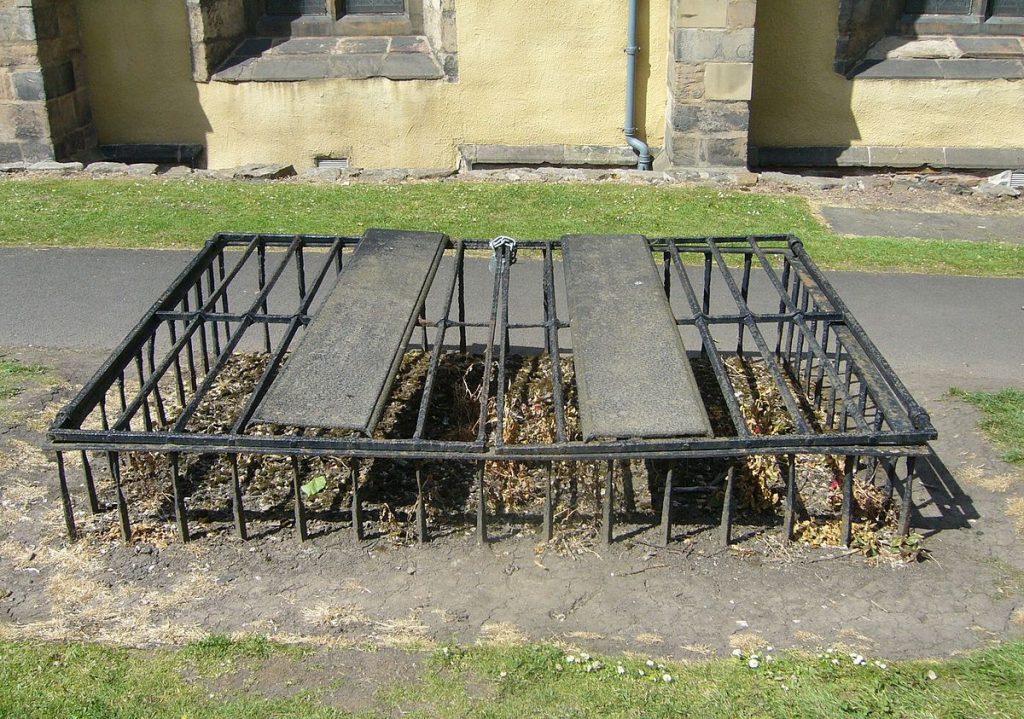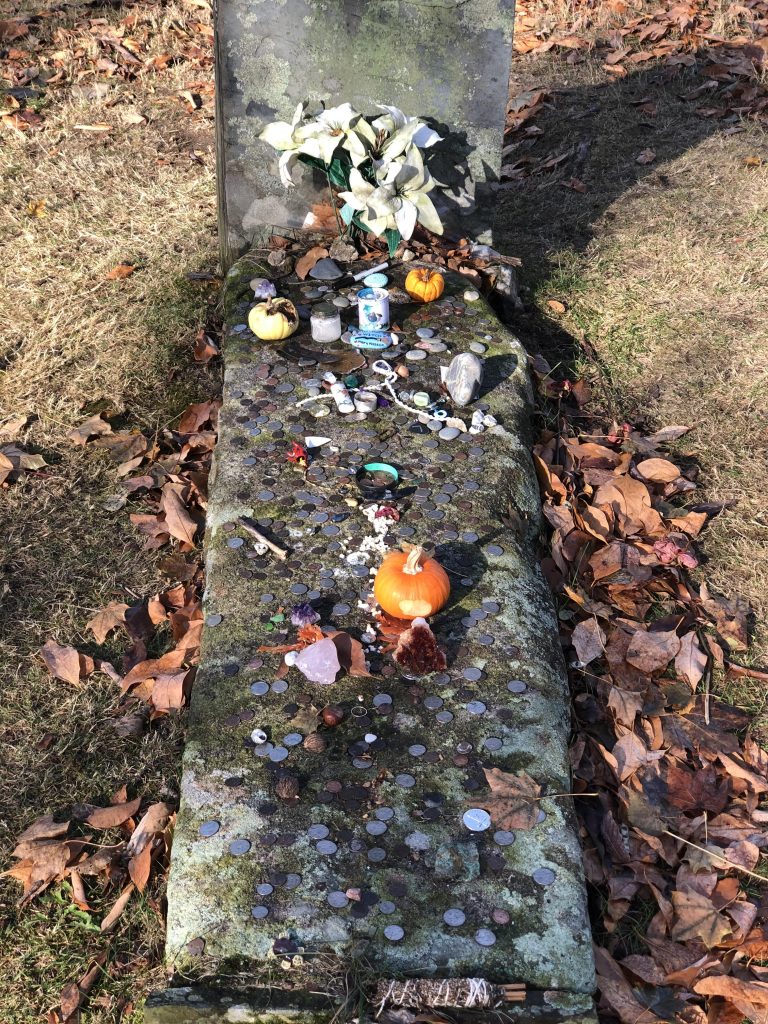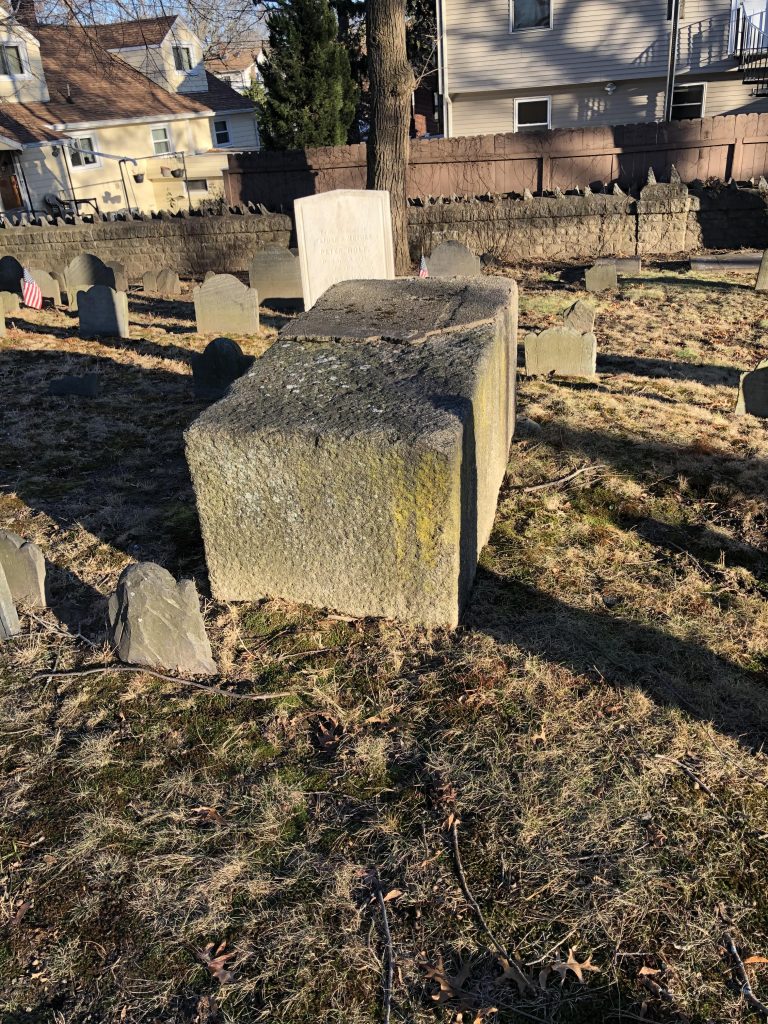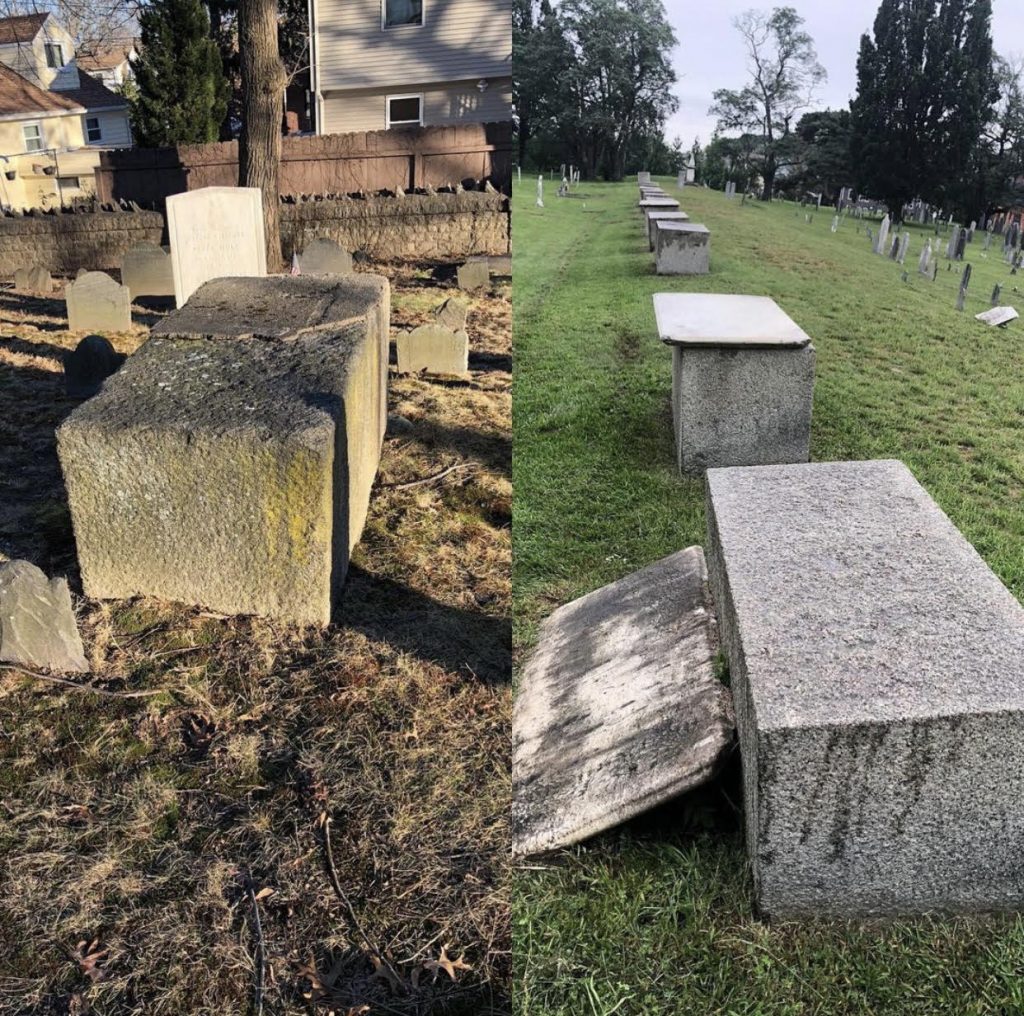“When we were kids we called that the grave of the witch.”
“We used to call that Frankenstein’s Tomb!”
“That was the grave of Paul Revere’s horse back when we played hide and seek in there.”
“Some people say there were tunnels leading down to this area from the church. That may block up the entrance to one of them.”
Oftentimes the unfamiliar features of old cemeteries lead to speculation about their purposes. This speculation usually takes the form of whimsical stories, and sometimes it becomes local folklore. Take for example the mortsafe, which originated in Scotland in the early 1800s. Surviving examples of mortsafes have made people surmise that their superstitious forebears used them to keep vampires in the ground. Mortsafes were designed to keep corpses in place, but not because of fear of the undead. They were meant to make it difficult for grave robbers to dig up bodies to sell to medical schools. Still ghoulish, but not supernatural.

A more local example is York, Maine’s “grave of the witch.” Mary Nasson died in 1774, and over the years her grave led many to speculate that she was a witch. One reason was the carving on the tympanum of the gravestone: a robed woman with an uncharacteristically low neckline and a hairstyle that recalls Gary Oldman in the early scenes of Francis Ford Coppola’s Bram Stoker’s Dracula. Another “witchy indicator” is the long concrete slab placed on the ground behind Mary Nasson’s headstone. People began to believe this stone was placed there to keep the witch in her grave. Some even embellished the story to include the idea that if you touched the stone it would always be hot, due to the witch burning in Hell’s fires.

This is, of course, ludicrous and defamatory to this woman’s memory. The depiction of a woman on the gravestone is not an attempt at a portrait of Mary Nasson – there is an identical carving on the grave of Sarah McKean (1776) in Ipswich. And the stone was placed there to keep her in her grave, but just like in the case of the mortsafes, not because she might return as an undead being. This type of stone is called a wolfstone, which was placed over graves to deter wolves and other animals from digging up corpses. Their rarity today is due to the fact that most of them were recycled to help construct the low walls that surround many old New England cemeteries. It’s also likely that some of them sank into the ground and were grown over.

All this brings us back to the large concrete block that sits in the middle of RMBG. It bears no inscription and has mystified countless visitors to RMBG over the years. The quotes at the beginning of this article are real quotes from Reverians who have pondered the significance of this block from the latter half of the 20th Century until now. When I started working with the RMBG Committee I had no idea what the block was, but through some research I found that it isn’t the final resting place of Frankenstein, a witch, or Paul Revere’s horse. The block marks the grave of Revere’s “Fighting Pastor” Phillips Payson and his wife Elizabeth.

The “Fighting Pastor” is an interesting figure in Revere’s history. Payson was born in Walpole on January 18, 1735/6. He married Elizabeth Stone in 1758 and they had five children, several of whom are buried around them in RMBG. He was ordained pastor in Chelsea (which contained Revere at the time) in 1757 and preached until his death in 1801.
Payson got his nickname during the Revolutionary War. According to historical sources he took his time deciding who to back as the Revolution was heating up. He made up his mind decisively, however, when he rounded up a group of men and attacked a small British troop. In his 1938 book, Benjamin Shurtleff describes the engagement like this:
During this war for independence, the citizens of Chelsea rendered good service to the cause both at home and in other fields. Rev. Phillips Payson … rendered essential service not only by his papers on political and constitutional questions, but also by enlisting troops and placing himself at their head for which he was called the “fighting parson” … When Lord Percy went to the relief of Colonel Smith’s hard pressed troops with provisions, the convoy of the latter … fell behind the main party and was intercepted at West Cambridge, then known as a district named Menotomy, now Arlington. This convoy was captured by a few Americans headed by Rev. Mr. Payson of Chelsea, who … killed one, wounded several, made the whole prisoners and gained possession of their arms and stores, without any loss whatever to themselves.”
There are differing accounts about Payson’s further service in the field during the Revolution due to the presence of a Captain Samuel Phillips Payson who was present at the Battle of Lexington.
In addition to his brief military service, Payson was known as a scholar. Payson graduated from Harvard in 1754, where Shurtleff tells us he “distinguished himself by his knowledge of the dead languages, natural philosophy and astronomy.” Payson formed a school for young men who wished to be ministers, and was a charter member of the American Academy of Arts and Sciences, which was founded in 1780.
The resting place of Phillips and Elizabeth Payson wasn’t always a mystery. Whatever tablet once lay upon the concrete must have disappeared or been destroyed at some point in the mid 20th Century, for Shurtleff was able to include the inscription in his book:
Under this marble are interred the remains of the Rev. Phillips Payson DD who died January 11 1801 in the 65th year of his age and 44 year of his ministry.
Non animo victus sed fato fractus obibat
Also the remains of Mrs. Elizabeth Payson wife of the Rev. Doctor Payson, who died September 25, 1800 in the 66th year of her age.
Blessed are the dead which die in the Lord! That they may
Rest from their labours; and their works do follow them

Researched and written by Brendan O’Brien, February 2021.
